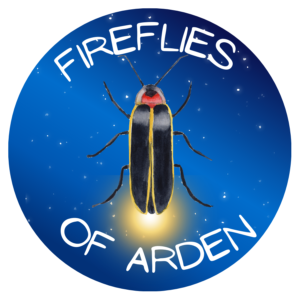Arden Firefly Watch
Join us June 15th-July 14th to observe and record fireflies in our Arden-on the Severn community. These magical, glowing creatures help our environment in different ways. In particular, many fireflies are important predators in our landscapes. Unfortunately, firefly populations seem to be declining in areas around the United States. Help us document the fireflies in Arden while also learning about these cool creatures!

About Fireflies
Did you know that fireflies aren’t actually flies but are beetles?! Not all fireflies glow, either! There are around 2,000 species of fireflies around the world. In Maryland, just over 30 species have been documented but not all are common.
The name ‘firefly’ or ‘lightening bug’ comes from the fact that many species use bioluminescence (glowing in the dark) to communicate. Another group of creatures, glowworms, can also glow at night. Glowworm females lack wings, but fireflies have wings (at least during part of their lifecycle).
Fireflies are beetles that hatch from eggs that also glow. The young fireflies are known as larvae, and many are carnivorous. They spend much of their time underground and will eat snails, worms, and slugs. Many times, these larvae will inject their prey with a numbing chemical to disable. When they become adult fireflies, they will eat other fireflies, nectar, or pollen. Some adult fireflies don’t eat at all.
About the Arden Firefly Watch
For one month (June 15th-July 14th), we encourage you to document and submit data on fireflies that you see in your backyard. Essentially, we would love for you to go outside for at least 10 minutes a week and document what you see. We’ll provide a set of directions on how to record and submit your data. All who participate will get their own Arden Firefly Watch sticker, and we will have a competition (to win a free Firefly Habitat Certification sign from Firefly.org) to see who can make the most observations!
How to Join
Fill out this form to register your yard. We also ask that you download iNaturalist for free in either the Google or Apple store to participate in the project. Make an iNaturalist account and get ready to submit data over the course of the month for the project! You can also make other observations of plants and wildlife in your area on iNaturalist, too.
Events:
- Kick-off webinar on Thurs June 13th at 6:30 pm
- June 22nd Night Hike registration
On Sat June 22nd, we will have a guided blacklight night hike looking for fireflies, fungi, and other things that glow in the night!
Steps to Record Data
Step 1: Download iNaturalist on a phone or other device and create an account. (see links under How to Join)
Step 2: Choose at least one night a week to go out during the survey period.
Step 3: After sunset, sit outside for at least 10 minutes to observe fireflies. Either record a video of their flashing and/or take pictures of fireflies that you see.
Step 4: Upload your observations to iNaturalist.
Helpful tips:
- Try to add notes with your videos and/or pictures.
- With the notes, include information like the air temperature, the flash patterns (being repeated in 1, 2, or 3-9 flashes), basic habitat information (like backyard) etc.
- If taking a picture of a captured firefly, try to take a picture of the top and the bottom. Use a clear container or plastic bag to hold the firefly for photos. Include a ruler or other measurement tool to help with identification.
Step 5: Repeat throughout the survey!
Give Fireflies a Boost
While firefly populations are declining, you can help give them a boost in your own backyard by employing wildlife-friendly practices. These include:
- Reducing outdoor lighting at night.
- Leaving the leaves.
- Providing rotting logs.
- Reducing pesticide use.
- Certifying your yard!
Resources for Kids
Helpful Resources
-
- Twinkle, Twinkle Little Firefly blog by The Humane Gardener
-
- Fireflies talk by Ben Pfeiffer
Questions?
Reach out to Kerry Wixted or Marjorie Kehoe for more information.
